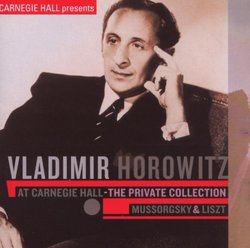| All Artists: Vladimir Horowitz Title: At Carnegie Hall: Private Collection Members Wishing: 0 Total Copies: 0 Label: RCA Red Seal Release Date: 7/13/2009 Album Type: Import Genre: Classical Styles: Chamber Music, Historical Periods, Classical (c.1770-1830) Number of Discs: 1 SwapaCD Credits: 1 UPC: 886975388523 |
Search - Vladimir Horowitz :: At Carnegie Hall: Private Collection
CD Details |
CD ReviewsHorowitz at his most flamboyant and thrilling Santa Fe Listener | Santa Fe, NM USA | 09/21/2009 (5 out of 5 stars) "I can only echo Mr. Drake's enthusiasm and welcome his detailed review. Horowitz in his prime displayed a unique kind of restless nerve that kept audiences mesmerized. After a rumored breakdown and retirement, he returned a different man, just as arbitrary and eccentric musically but without the cover of his earlier hypnotic quality, which was due for the most part to eye-popping technique. In these concert-hall acetates from the late Forties, which retain a background hiss and crackle, just enough to allow the treble not to be smothered, we hear the real, wild Horowitz in two signature works.
As Mr. Drake notes, both performances fill in a stylistic gap by offering just enough taming of the beast that the Liszt B minor Sonata doesn't sound over-rushed and Pictures at an Exhibition retains the excitement of a live event. Of the two, I think he's also right that the Liszt is more valuable. Horowitz was the dominant Lisztian of his day and deliberately tried to recreate the original hysteria surrounding Liszt's demonic pianism. He doesn't turn the sonata into a more serious work but takes it as it is, a turbulent romantic rhapsody loosely disguised in sonata form. Pictures, on the other hand, is so reworked that one almost winces. Horowitz throws in little clinkers in the highest register to add frisson to Mussorgsky's original, rather plain harmonies (a few clinkers are finger slips, though), and the effect certainly wakes the listener up. But things go overboard with octave doublings, tremolos, added bass, etc. that in the end disrespects the composer's original. While he's performing, Horowitz brilliantly carries off each episode, but you still realize that at bottom his revisions are a travesty. Sonically, Pictures is not successful, the piano sounding dry and wooden. Things improve considerably for the Liszt, where the piano sound actually has a bit of bloom, even though the bass is quite limited." |

